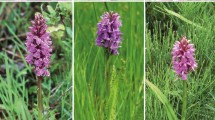Abstract
arising from A. E. Zanne et al. Nature 506, 89–92 (2014); doi:10.1038/nature12872
Zanne et al.1,2 addressed an important evolutionary question: how did flowering plants repeatedly enter cold climates? Herbaceous growth, deciduous leaves, and narrow water-conducting cells are adaptations to freezing. Using phylogenetic analyses, they concluded that herbs and narrow conduits evolved first in the tropics (“trait first”), facilitating movement into freezing areas, but that deciduous leaves evolved in response to freezing temperatures (“climate first”). Unfortunately, even after correcting for an error that we uncovered3, the “striking findings” of Zanne et al.1 seem inconclusive; here we highlight methodological issues of more general interest and question the value of their approach. There is a Reply to this Brief Communication Arising by Zanne, A. E. et al. Nature 521, http://dx.doi.org/10.1038/nature14394 (2015).

Similar content being viewed by others
Change history
22 May 2015
An earlier version of the proof was inadvertently used; this has now been corrected.
References
Zanne, A. E. et al. Three keys to the radiation of angiosperms into freezing environments. Nature 506, 89–92 (2014).
Zanne, A. E. et al. Corrigendum: Three keys to the radiation of angiosperms into freezing environments. Nature 514, 394 (2014).
Zanne, A. E. et al. Corrigendum: Three keys to the radiation of angiosperms into freezing environments. Naturehttp://dx.doi.org/10.1038/nature14371 (this issue).
Guralnick, R. P., Hill, A. W. & Lane, M. Towards a collaborative, global infrastructure for biodiversity assessment. Ecol. Lett. 10, 663–672 (2007).
Ponder, W. F., Carter, G. A., Flemons, P. & Chapman, R. R. Evaluation of museum collection data for use in biodiversity assessment. Conserv. Biol. 15, 648–657 (2001).
Donoghue, M. J. & Edwards, E. J. Biome shifts and niche evolution in plants. Annu. Rev. Ecol. Evol. Syst. 45, 547–572 (2014).
Author information
Authors and Affiliations
Contributions
E.J.E., J.M.d.V. and M.J.D. designed the study; J.M.d.V. wrote all scripts for analyses; E.J.E. and J.M.d.V. analysed the data; E.J.E., J.M.d.V. and M.J.D. wrote the manuscript.
Corresponding author
Ethics declarations
Competing interests
Competing Financial Interests Declared none.
PowerPoint slides
Rights and permissions
About this article
Cite this article
Edwards, E., de Vos, J. & Donoghue, M. Doubtful pathways to cold tolerance in plants. Nature 521, E5–E6 (2015). https://doi.org/10.1038/nature14393
Received:
Accepted:
Published:
Issue Date:
DOI: https://doi.org/10.1038/nature14393
- Springer Nature Limited
This article is cited by
-
A Comparative Study between Evergreen and Deciduous Daylily Species Reveals the Potential Contributions of Winter Shoot Growth and Leaf Freezing Tolerance to Foliar Habits
Journal of Plant Growth Regulation (2020)
-
Hydraulic basis for the evolution of photosynthetic productivity
Nature Plants (2016)
-
Zanne et al. reply
Nature (2015)





